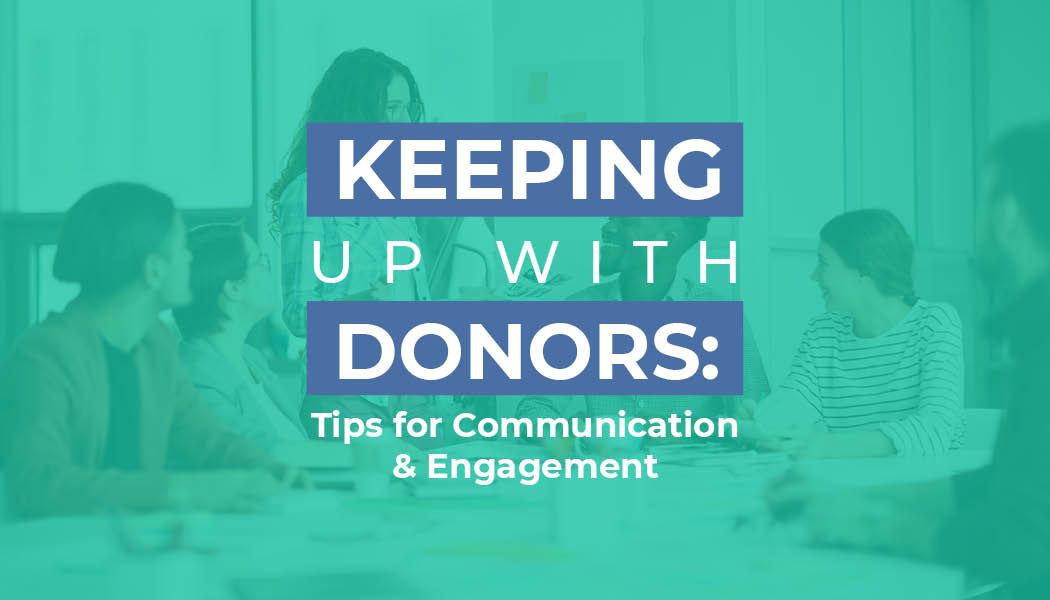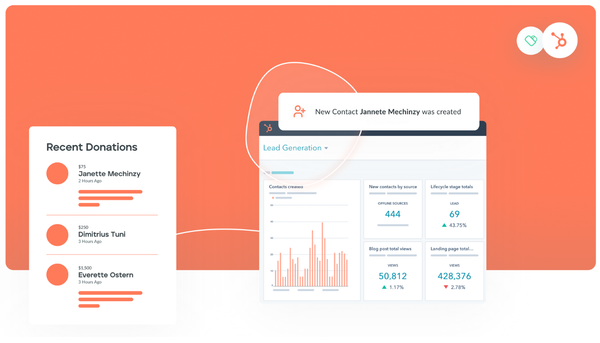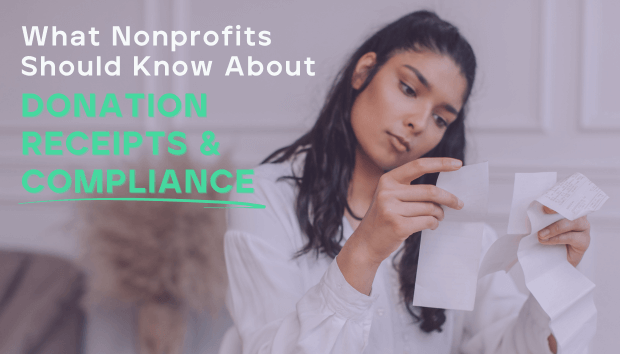Keeping Up With Donors: Tips for Communication & Engagement
Effective donor communication is vital for maintaining engagement and building long-term supporter relationships. Here are 6 of our favorite tips for doing so.

A huge part of any organization’s fundraising strategy should be ensuring strategic communication with donors. Whether you’re sending specific fundraising asks or incorporating supporters into your ongoing stewardship efforts, having a detailed plan in place is critical.
After all, effective communication and engagement strategies can go a long way for improving the donor journey and keeping supporters involved with your mission in the long run. Here are a few best practices to consider as you craft and develop your donor relations and communications plan:
- Incorporate matching gifts.
- Take a multi-channel approach.
- Automate outreach when possible.
- Leverage clear calls to action.
- Use data-driven strategies.
- Show your appreciation.
Regardless of the methods you choose to engage with your donors, the important thing is that you emphasize supporters’ critical role in your organization’s success. At the end of the day, they should feel like key mission partners rather than records in your nonprofit database—or worse, ATMs at your disposal.
Ready to find out how you can prioritize effective communication and keep donors highly engaged with your cause? Let’s dive in.
1. Incorporate matching gifts.
If you’re looking for a new and engaging way to boost communication with your donors, consider incorporating matching gift opportunities.
Unfortunately, there’s a huge knowledge gap when it comes to corporate giving and how to get involved, so you and your donors might not know where to start. We suggest the following steps to improve donor engagement and drive funding for your cause:
1. Educate supporters on the power of matching gift programs and encourage them to research their own eligibility. Millions of donors work for companies that offer matching gifts, but the vast majority of these individuals are unaware of these programs in place. Taking the time and effort to educate eligible donors on these opportunities can go a long way for increasing participation.
2. Provide donors with detailed information about their employers’ giving programs. Often made available through a searchable corporate giving database, sharing guidelines like donation minimums and maximums, ratios, and eligible nonprofits can help donors easily determine whether their gift is likely to be matched without requiring a ton of effort on their part.
3. Guide eligible donors toward next steps for requesting a corporate match. This often involves filling out an online form through their employer, so consider linking to the form itself, an online CSR platform, or instructions for their company’s procedure.
4. Follow up throughout the process. If you notice that a match-eligible individual has not submitted a match request, consider reaching out to remind them! You’ll want to follow up after they have requested a match along with once your team has received the money from their employer.
By promoting this unique giving opportunity, you can collect double the fundraising revenue for little to no added effort on your part. Plus, donors love matching gifts because they essentially allow an individual’s gift to go twice as far towards the mission they care about.
2. Take a multi-channel approach.
Multi-channel communication allows organizations to reach supporters through a variety of different avenues. This approach equips your team to best capture supporters’ attention and diversify your outreach strategy.
Commonly used communication and fundraising channels might include:
- Website
- Direct mail
- Text
- Phone calls
- Social media
Just remember, it’s important that your communications maintain a central focus and consistent branding strategy throughout every channel to ensure a cohesive engagement effort. However, it’s a good idea to adjust your messaging slightly for each avenue to best target highly successful content on that channel.
For example, text message communications will likely be very text-based, while social media should incorporate eye-catching visuals supplemented by relevant copy.
3. Automate outreach when possible.
Manual communication can require a lot of time and effort from your organization, especially if your network of donors is fairly large. Luckily, automation can help streamline and simplify that process for your team.
For example, if you’re looking to promote matching gift opportunities to donors, an automation tool can screen donors for common eligibility criteria and trigger customizable responses as a result. This allows you to save time that would otherwise have been spent crafting individual messages to donors while still leveraging the power of personalized messaging and specific donor insights.
4. Leverage clear calls to action.
Every communication should incorporate a prominent call to action that drives recipients further down the conversion funnel. This CTA essentially establishes what the intended result of the message is and encourages supporters to take your next steps. For donor communications, this might include the following tasks:
- Make a donation to a specific campaign.
- Sign up for a regular newsletter.
- Register to attend an upcoming event.
- Follow your profiles on social media accounts.
- Research their matching gift eligibility.
The bottom line is to make your call to action as simple to follow as possible. For digital engagements like social media or email messaging, this will likely include a clear, distinct, and clickable link or button sending users to your organization’s website. For offline strategies like direct mail and other printed materials, it might mean a shortened, easy-to-type URL or scannable QR code directing supporters to the intended pages on your site.
5. Use data-driven strategies.
Leveraging donor data in your communication strategies is an excellent way to make use of the information you already have to ensure positive results and better relationships. Consider the following data points to track and leverage in your messaging:
1. Gift size: Grouping donors by gift level allows you to pay close attention to your highest-value supporters. For example, all donors might receive an automated email acknowledgment, while you reserve phone call follow-ups for mid-level or major donors.
2. Communication preferences: A multi-channel strategy is great, but it doesn’t matter how much effort you put into crafting the perfect email if the donor never checks their inbox! That’s why knowing and using a donor’s preferred communication channel is great for maximizing results. You can determine this information by tracking response rates or even outright asking supporters how they’d like to be contacted.
3. Employer: It’s a good idea to keep track of your donors’ employers as well. This way, you can determine whether they’re employed by companies with top matching gift programs and help you increase revenue that way.
The more you know about your donors, the better you can cater your efforts to their specific wants and needs. When you segment your audience based on key characteristics like the above, you ensure your communications are relevant, personalized, and most likely to result in the intended action.
6. Show your appreciation.
Make sure your donor relationships don’t taper off once you’ve received your gift. Instead, now is the time to put extra effort into communicating appreciation for donor support and acknowledging their contributions in a variety of ways.
Here are some of our favorite ideas for switching up your donor communication approach during this stage:
-
Send personalized thank-you notes. Sending thank-you notes is a simple and personal way to communicate your gratitude to donors. You can even start with a thank-you letter template, but don’t forget to customize your messaging for each recipient!
-
Make sure not every communication is an ask. Donors will get burnt out quickly if every communication they have with your organization is a financial ask. Diversify your approach by including messages of appreciation, information about your mission, and powerful stats and stories that demonstrate your results.
-
Communicate donors’ giving impact. One of the most effective ways to get supporters further involved in your organization is by showing them exactly how their dollars are driving your mission forward. Consider including real examples of the tangible impacts made by a donor’s gift. If an individual gave $100, let them know that you were able to feed 50 hungry children with that funding.
And remember, if a donor goes above and beyond in their giving, it’s important that you match their efforts in your appreciation strategies. For example, you’ll want to put more effort into appreciation and stewardship for your major and recurring donors than your smaller-level, one-time givers.
Additionally, if an individual participates in a corporate giving program, such as by securing a matching gift from their employer for your organization, that deserves further acknowledgment as well!
Effective donor communication sets an organization up for continued fundraising success by strategically engaging with key stakeholders. Remember, you wouldn’t be able to pursue your mission without generous supporter contributions, so investing the time and effort into your ongoing communications is critical.
Plus, it’s a great way to encourage participation in additional giving opportunities such as matching gifts as well. Good luck!
Author: Adam Weinger
Adam Weinger is the President of Double the Donation, the leading provider of tools to nonprofits to help them raise more money from corporate matching gift and volunteer grant programs.
Double the Donation's robust solution, 360MatchPro, provides nonprofits with automated tools to identify match-eligible donors, drive matches to completion, and gain actionable insights. 360MatchPro integrates directly into donation forms, CRMs, social fundraising software, and other nonprofit technology solutions to capture employment information and follow up appropriately with donors about matching gifts.





